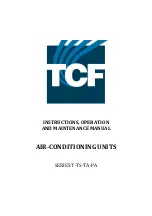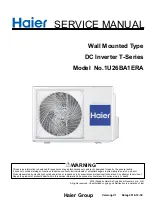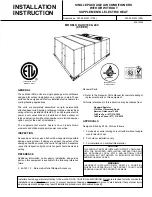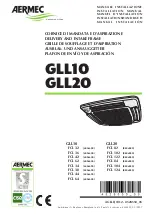
6
7. Installing refrigerant piping
8. Installing drain piping
7/16 to 13/16
1-3/16 to 2
5 to 7 ft 9-7/8 inch
7-7/8
15/16
13/16
11
11
10
10
7-7/8
13/16
11
11
3/8 to 3/4
3/8 to 3/4
Caution:
Tighten the flare nut with a torque wrench in the specified method.
Overtightening will cause the flare nut to crack and it will cause refrigerant
leakage over a period of time.
C
Apply refrigeration oil to the entire (Fig. 7-2) surface of the flared seat.
D
Basically use flared nuts fitted to the body (commercially available flared nuts
may crack).
Note:
A special flare nut (optional or attached to the indoor unit) is needed to
some indoor units.
Please refer to the installation manual of outdoor unit and indoor unit for
details.
F
Band
9
G
Pipe covers
3456
H
Tighten
J
Refrigerant piping
L
Thermal insulation for refrigerant piping
► Use the following procedures for indoor connection part which indoor
unit is not connected. (Fig. 7-4)
(1) In order to prevent refrigerant leaks, make sure that the flare nuts are tightened
according to the specified torques* in Table 3.
* Refrigerant may also leak if the flare nuts are tightened more than the speci-
fied torques.
() In order to prevent condensation, install the pipe covers
7
8
and fasten them
with the supplied bands
9
.
Table 3
Diameters of branch box openings for
connecting indoor units (inch, mm)
Tightening torque
(ft•lbs, N•m)
1/4, ø6.35
8-11, 13 ±
3/8, ø9.5
1-4, 30 ±
1/, ø1.7
35-38, 50 ±
► Refrigerant charge:
Refer to the installation manual of the outdoor unit.
Use only R410A refrigerant (use of other refrigerants may cause troubles).
• To ensure that the drain piping has a down-gradient (greater than 1/100),
do not make traps or humps in piping.
• Install thermal insulation to prevent condensation dripping.
• Ensure that the horizontal length (not diagonal length) of drain piping does not
exceed 66 ft. (20 m). If the drain piping extends over a significant distance,
install supports to ensure that the piping does not sag. Do not fit air bleed pipes
under any circumstances (water may exit from air bleed pipes).
• Do not fit odor traps at drain piping outlets.
• Install drain outlets in locations where odors will not present problems.
• Do not place drain piping directly in drains which may contain sulfurous gases.
• Drain piping may be installed in any direction provided the above requirements
are followed.
• Keep bends of attached drain hose to a maximum of 45˚.
(1) Apply PVC adhesive (procure locally) to the drain connection on the branch
box and push the attached drain hose
0
onto the connection as far as it will
go. (Fig. 8-1)
() Insert a hard PVC pipe (O.D. 13/16 inch, 0 mm, procure locally) into the at-
tached drain hose
0
and glue it together and fix it. (Fig. 8-1)
A
O.D. 13/16 inch, 0 mm procured locally
B
Thermal insulation
(3) Fit a band
1
to the attached drain hose
0
(Fig.8-1)
(4) Ensure that the drain piping down-gradient is greater than 1/100. (Fig. 8-)
C
Supports
D
Down-gradient greater than 1/100.
E
Thermal insulation
Type A
Type B
(inch)
Note:
The drain hose is available in either Type A or Type B.
The installation methods are different between Type A and Type B.
Caution:
To avoid excessive strain on the branch box, support the piping with one or
more support(s) 5 ft or less from the branch box.
Refer to Fig. 7-5 as an example.
J
Refrigerant piping
L
Thermal insulation for refrigerant piping
(inch)
Fig. 7-4
Fig. 7-5
Fig. 8-1
Fig. 8-2
5 ft or less
Support
Pipe cover







































